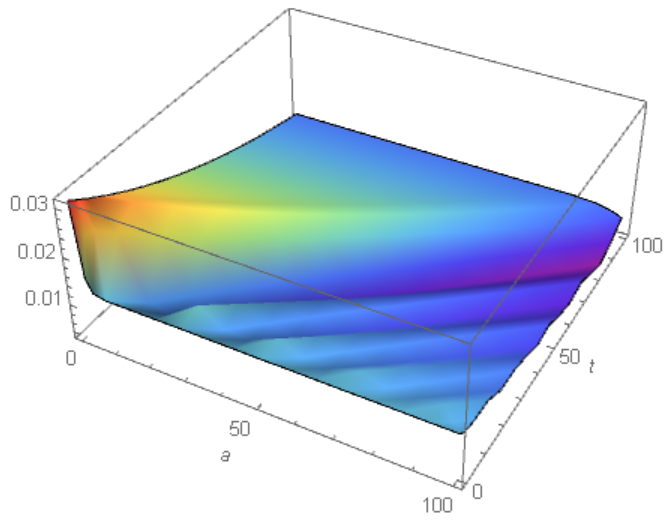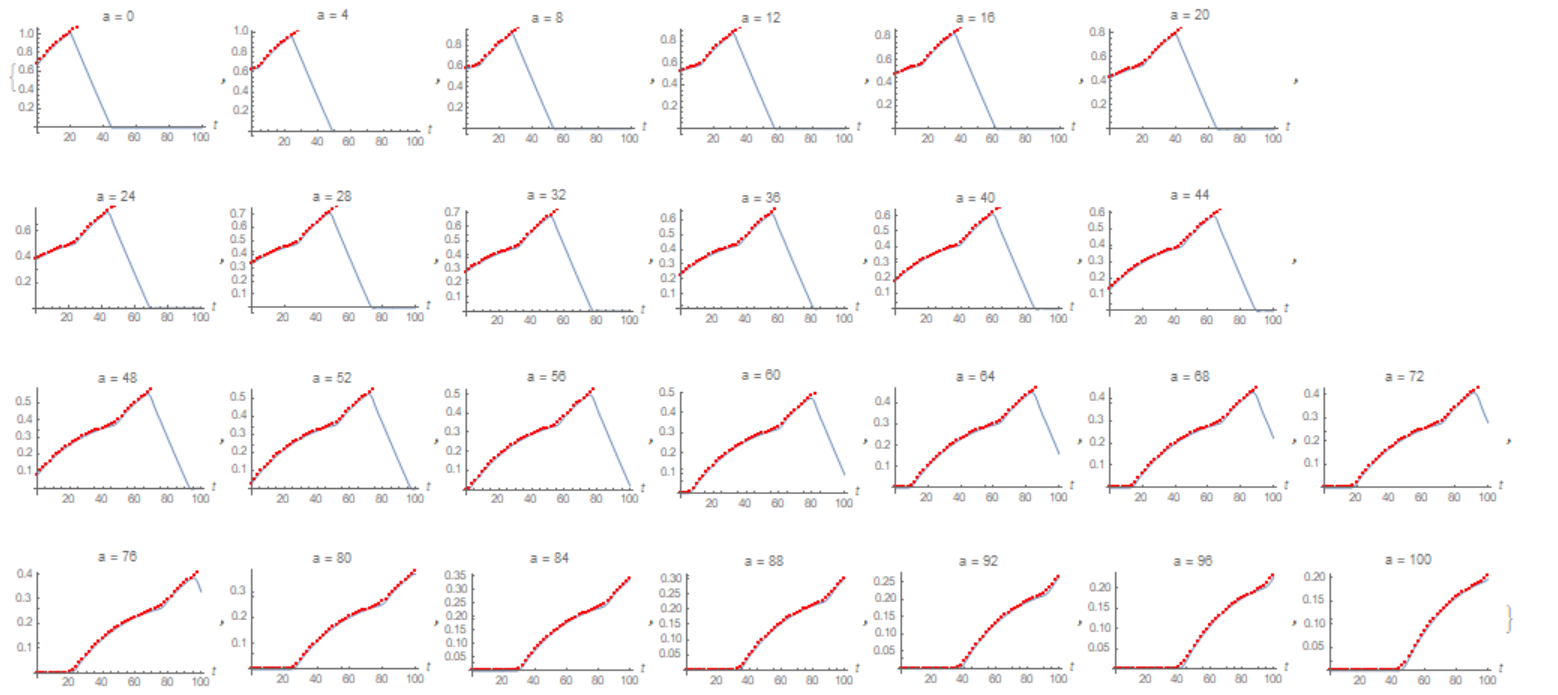There is no unique solution for data provided by @Pillsy, since boundary and initial conditions are inconsistent. To show it we just use exact solution in a form:
\[Mu][a_] := 1/80; u0[a_] := 1/80;
u[a_, t_] :=
E^(Inactive[Integrate][-\[Mu][K[1]], {K[1], 1, a}] -
Inactive[Integrate][-\[Mu][K[1]], {K[1], 1, a - t}])*u0[a - t]
u[0, t_] := Integrate[u[x, t], {x, 20, 45}]/25;
Now we can plot u[0,t] as follows:
Plot[u[0, t], {t, 0, 100}]
 So it is smooth function and we can make interpolation in a form
So it is smooth function and we can make interpolation in a form
lst = Table[{t, u[0, t] // N}, {t, 0, 100, 1}];
ut = Interpolation[lst];
With ut we can use NDSolve directly
sol = NDSolveValue[{D[v[a, t], a] + D[v[a, t], t] == -\[Mu][a]*
v[a, t], v[a, 0] == u0[a], v[0, t] == ut[t]},
v, {a, 0, 100}, {t, 0, 100}]
Here we got message NDSolveValue::ibcinc: Warning: boundary and initial conditions are inconsistent. Nevertheless numerical solution can be plot and it looks like waved function
Plot3D[sol[a, t], {a, 0, 100}, {t, 0, 100}, Mesh -> None,
ColorFunction -> "Rainbow", AxesLabel -> Automatic]
 To avoid the inconsistent of boundary and initial conditions we put in the beginning of the code
To avoid the inconsistent of boundary and initial conditions we put in the beginning of the code
u[0, t_] := Integrate[u[x, t], {x, 20, 45}]/25;
Then we get smooth numerical solution

Now we can use method of line implemented by Chris K with some appropriate modifications
Clear[u];
imax = 200;
da = 1/2;
f[a_] := If[20 <= a < 45, 1/25, 0];
\[Mu][a_] := 1/80;
u0[a_] := 1/80;
eqns = Join[{u[0]'[t] ==
da/2 Sum[(u[i + 1]'[t] f[(i + 1) da] + u[i]'[t] f[i da]), {i, 0,
imax - 1}]},
Table[u[i]'[
t] == -(u[i][t] - u[i - 1][t])/da - \[Mu][i da] u[i][t], {i, 1,
imax}]];
ics = Table[u[i][0] == u0[i da], {i, 0, imax}];
unks = Table[u[i], {i, 0, imax}];
tmax = 100;
sol1 = NDSolve[{eqns, ics}, unks, {t, 0, tmax}][[1]];
We make visualization of numerical solution of the system of ODEs and see identical picture as we got for PDE
ListPlot3D[
Flatten[Table[{i da, t, Evaluate[u[i][t] /. sol1]}, {i, 0, imax}, {t,
0, tmax, 1}], 1], AxesLabel -> {"a", "t", "u"},
ColorFunction -> "Rainbow", PlotRange -> All, Mesh -> None]
 And more detailed comparison also shows agreement of two solutions
And more detailed comparison also shows agreement of two solutions
Show[Plot[{sol[10, t]}, {t, 0, 100}],
ListPlot[Table[{t, u[20][t] /. sol1}, {t, 0, 100, 2}],
PlotStyle -> Red]]

One example of growing population with consistent boundary and initial conditions:
\[Mu][a_] := 1/80; u0[a_] := Exp[-a/45];
f[a_] := Piecewise[{{1/10/1.2298542626633067, 20 <= x < 45}, {0,
True}}];
ue[a_, t_] :=
E^(Inactive[Integrate][-\[Mu][K[1]], {K[1], 1, a}] -
Inactive[Integrate][-\[Mu][K[1]], {K[1], 1, a - t}])*u0[a - t]
u1[t_] := NIntegrate[ue[x, t] f[x], {x, 0, 100}] // Quiet;
lst = Table[{t, u1[t]}, {t, 0, 100, 1}];
ut = Interpolation[lst];
sol = NDSolveValue[{D[v[a, t], a] + D[v[a, t], t] == -\[Mu][a]*
v[a, t], v[a, 0] == u0[a], v[0, t] == ut[t]},
v, {a, 0, 100}, {t, 0, 100}]
Visualisation
Plot3D[sol[a, t], {a, 0, 100}, {t, 0, 100}, Mesh -> None,
ColorFunction -> "Rainbow", AxesLabel -> Automatic]

And same solution with method of lines:
imax = 500;
da = 100/imax;
f[a_] := If[20 <= a < 45, 1/10/1.2298542626633067, 0];
\[Mu][a_] := 1/80;
u0[a_] := Exp[-a/45];
eqns = Join[{u[0]'[t] ==
da/2 Sum[(u[i + 1]'[t] f[(i + 1) da] + u[i]'[t] f[i da]), {i, 0,
imax - 1}]},
Table[u[i]'[
t] == -(u[i][t] - u[i - 1][t])/da - \[Mu][i da] u[i][t], {i, 1,
imax}]];
ics = Table[u[i][0] == u0[i da], {i, 0, imax}];
unks = Table[u[i], {i, 0, imax}];
tmax = 100;
sol1 = NDSolve[{eqns, ics}, unks, {t, 0, tmax}][[1]];
Let compare two solution and find out that they have small discrepancies (due to large da)
Table[Show[
Plot[{sol[i da, t]}, {t, 0, 100}, AxesLabel -> Automatic,
PlotLabel -> Row[{"a = ", i da}]],
ListPlot[Table[{t, u[i][t] /. sol1}, {t, 0, 100, 2}],
PlotStyle -> Red]], {i, 0, imax, 20}]

Last example provided by Pillsy shows divergence of two solutions found out with two methods even if initial data and boundary conditions are consistent. First method:
\[Mu][a_] := 1/80; u0[a_] := If[0 <= a <= 325/6, 65/96 - a/80, 0];
f[a_] := Piecewise[{{1/10, 20 <= x < 45}, {0, True}}];
ue[a_, t_] :=
E^(Inactive[Integrate][-\[Mu][K[1]], {K[1], 1, a}] -
Inactive[Integrate][-\[Mu][K[1]], {K[1], 1, a - t}])*u0[a - t]
u1[t_] := NIntegrate[ue[x, t], {x, 20, 45}]/10 // Quiet;
lst = Table[{t, u1[t]}, {t, 0, 100, 1/4}];
ut = Interpolation[lst];
sol = NDSolveValue[{D[v[a, t], a] + D[v[a, t], t] == -\[Mu][a]*
v[a, t], v[a, 0] == u0[a], v[0, t] == ut[t]},
v, {a, 0, 100}, {t, 0, 100}];
Second method:
imax = 500;
da = 100/imax;
f[a_] := If[20 <= a < 45, 1/10, 0];
\[Mu][a_] := 1/80;
u0[a_] := If[0 <= a <= 325/6, 65/96 - a/80, 0];
eqns = Join[{u[0]'[t] ==
da/2 Sum[(u[i + 1]'[t] f[(i + 1) da] + u[i]'[t] f[i da]), {i, 0,
imax - 1}]},
Table[u[i]'[
t] == -(u[i][t] - u[i - 1][t])/da - \[Mu][i da] u[i][t], {i, 1,
imax}]];
ics = Table[u[i][0] == u0[i da], {i, 0, imax}];
unks = Table[u[i], {i, 0, imax}];
tmax = 100;
sol1 = NDSolve[{eqns, ics}, unks, {t, 0, tmax},
Method -> {"EquationSimplification" -> "Residual"}][[1]];
Now we plot solutions together and see divergence
Table[Show[
Plot[{sol[i da, t]}, {t, 0, 100}, AxesLabel -> Automatic,
PlotLabel -> Row[{"a = ", i da}]],
ListPlot[Table[{t, u[i][t] /. sol1}, {t, 0, 100, 2}],
PlotStyle -> Red, PlotRange -> All]], {i, 0, imax, 20}]

Nevertheless, we can consider all tests above as verification of numerical method of lines for this problem. Now we make next step to develop code with known error of $h^4$, where $h$ is step size. For this we use function GaussianQuadratureWeights[] to integrate with n-point Gaussian formula for quadrature, and function FiniteDifferenceDerivative for approximation of derivative $\frac {\partial u}{\partial x}$ with DifferenceOrder of 4. First we call utilities:
Needs["DifferentialEquations`NDSolveProblems`"]
Needs["DifferentialEquations`NDSolveUtilities`"]
Get["NumericalDifferentialEquationAnalysis`"]
Second step, we define derivative matrix m and integral vector int:
np = 400; g = GaussianQuadratureWeights[np, 0, 100];
ugrid = g[[All, 1]]; weights = g[[All, 2]];
fd = NDSolve`FiniteDifferenceDerivative[Derivative[1], ugrid]; m =
fd["DifferentiationMatrix"]; vart =
Table[u[i][t], {i, Length[ugrid]}]; vart1 =
Table[u[i]'[t], {i, Length[ugrid]}]; ux = m.vart; var =
Table[u[i], {i, Length[ugrid]}];
f[a_] := If[20 <= a < 45, 1/10, 0]; int =
Table[f[ugrid[[i]]] weights[[i]], {i, np}];
\[Mu][a_] := 1/80;
u0[a_] := If[0 <= a <= 325/6, 65/96 - a/80, 0];
Third step, we define the system of equations:
eqns = Join[{D[u[1][t], t] == int.vart1},
Table[D[u[i][t], t] == -ux[[i]] - \[Mu][ugrid[[i]]] u[i][t], {i, 2,
Length[ugrid]}]];
ics = Table[u[i][0] == u0[ugrid[[i]]], {i, Length[ugrid]}];
Finally we solve system as
tmax = 100;
sol1 = NDSolve[{eqns, ics}, var, {t, 0, tmax},
Method -> {"EquationSimplification" -> "Residual"}];
With this code we made research to check how solution diverges with np increasing:
{np, {u[1][100] /. sol1[[1]], u[np][100] /. sol1[[1]]}}
{100, {4.0455, 0.197089}}
{200, {3.791317314610565`, 0.19572819660924937`}};
{400, {3.6951293716506926`, 0.1949809561721866`}};
{800, {3.70082201902361`, 0.19456320959442788`}};
So numerical solution converges very fast with np increasing, and for np=800 we have picture
lst1 = Flatten[
Table[{t, ugrid[[i]], u[i][t] /. sol1[[1]]}, {t, 0, 100, 2}, {i, 1,
Length[ugrid], 5}], 1];
ListPlot3D[lst1, Mesh -> None, ColorFunction -> Hue, PlotRange -> All,
AxesLabel -> {"t", "a"}]
 We have run several tests with known exact solution and got a good agreement of the exact and numerical solution getting with the last code. Example 1 from Numerical methods for the Lotka–McKendrick’s equation (there are typos in this paper in equations (6.8),(6,9) I have corrected using Mathematica 12.1):
We have run several tests with known exact solution and got a good agreement of the exact and numerical solution getting with the last code. Example 1 from Numerical methods for the Lotka–McKendrick’s equation (there are typos in this paper in equations (6.8),(6,9) I have corrected using Mathematica 12.1):
f[a_]:=2; \[Mu][a_] := 1/(1 - a);
p0[x_] := If[x <= 1/2, (1 - 2 x)^3 (1 - x), 31 (2 x - 1)^3 (1 - x)];
u0[a_] := p0[a];
With this data we have to compute u[a,t] on {a,0,1},{t,0,1} and then compare exact solution $u(0,t)=B(t)$ with numerical solution:
B[t_] := If[t <= 1/2,
217 - 186 t - 372 t^2 - 248 t^3 - 216 E^t Cos[t] + 396 E^t Sin[t],
1/(Sqrt[E] (Cos[1/2]^2 + Sin[1/2]^2)) (-7 Sqrt[E] Cos[1/2]^2 +
6 Sqrt[E] t Cos[1/2]^2 + 12 Sqrt[E] t^2 Cos[1/2]^2 +
8 Sqrt[E] t^3 Cos[1/2]^2 - 216 E^(1/2 + t) Cos[1/2]^2 Cos[t] +
768 E^t Cos[t] Sin[1/2] - 7 Sqrt[E] Sin[1/2]^2 +
6 Sqrt[E] t Sin[1/2]^2 + 12 Sqrt[E] t^2 Sin[1/2]^2 +
8 Sqrt[E] t^3 Sin[1/2]^2 - 216 E^(1/2 + t) Cos[t] Sin[1/2]^2 -
768 E^t Cos[1/2] Sin[t] + 396 E^(1/2 + t) Cos[1/2]^2 Sin[t] +
396 E^(1/2 + t) Sin[1/2]^2 Sin[t])];
In Figure 10 shown numerical solution (left) and exact solution (right, blue line) with numerical solution (red points):
 Finally we have to compare absolute error $|B(t)-u(0,t)|$ for code by Chris K and my code to find out accuracy of two code. For Chris code it is obvious that error is of
Finally we have to compare absolute error $|B(t)-u(0,t)|$ for code by Chris K and my code to find out accuracy of two code. For Chris code it is obvious that error is of h and for my code theoretically it should be of $h^3$. But since we solve PDE it is not so perfect. In Figure 11 shown absolute error for Chris code (left) and for my code (right) for imax=np=800. It looks like my code has error of $h^{3/2}$ not $h^3$.
 To improve the accuracy of my code we add point
To improve the accuracy of my code we add point a=0 to the grid for differentiation matrix and finally have
Needs["DifferentialEquations`NDSolveProblems`"];
Needs["DifferentialEquations`NDSolveUtilities`"]; \
Get["NumericalDifferentialEquationAnalysis`"];
np = 40; g = GaussianQuadratureWeights[np, 0, 1];
ugrid = g[[All, 1]]; weights = g[[All, 2]]; grid = Join[{0}, ugrid];
fd = NDSolve`FiniteDifferenceDerivative[Derivative[1], grid]; m =
fd["DifferentiationMatrix"]; vart =
Table[u[i][t], {i, Length[grid]}]; varti =
Table[u[i]'[t], {i, 2, Length[grid]}]; vart1 =
Table[u[i]'[t], {i, Length[grid]}]; ux = m.vart; var =
Table[u[i], {i, Length[grid]}];
\[Mu][a_] := 1/(1 - a);
p0[x_] := If[x <= 1/2, (1 - 2 x)^3 (1 - x), 31 (2 x - 1)^3 (1 - x)];
u0[a_] := p0[a];
f[a_] := 2; int = Table[f[ugrid[[i]]] weights[[i]], {i, np}]; eqns =
Join[{D[u[1][t], t] == int.varti},
Flatten[Table[
u[i]'[t] == -ux[[i]] - \[Mu][grid[[i]]] u[i][t], {i, 2,
Length[grid]}]]];
ics = Table[u[i][0] == u0[grid[[i]]], {i, Length[grid]}];
tmax = 1;
{bb, mm} = CoefficientArrays[eqns, vart1];
rhs = -Inverse[mm].bb;
sol1 = NDSolve[{Table[vart1[[i]] == rhs[[i]], {i, Length[vart1]}],
ics}, var, {t, 0, tmax}];
With this code we calculate absolute error in Example 1 for np=40(left picture) and np=80 (right picture). For this code error is of $h^{5/2}$.


















NDSolveValue::ibcinc: Warning: boundary and initial conditions are inconsistent.$\endgroup$